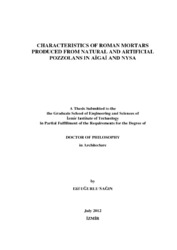Please use this identifier to cite or link to this item:
https://hdl.handle.net/11147/2929Full metadata record
| DC Field | Value | Language |
|---|---|---|
| dc.contributor.advisor | Böke, Hasan | - |
| dc.contributor.author | Uğurlu Sağın, Elif | - |
| dc.date.accessioned | 2014-07-22T13:48:37Z | - |
| dc.date.available | 2014-07-22T13:48:37Z | - |
| dc.date.issued | 2012-07 | - |
| dc.identifier.uri | http://hdl.handle.net/11147/2929 | - |
| dc.description | Thesis (Doctoral)--İzmir Institute of Technology, Architecture, İzmir, 2012 | en_US |
| dc.description | Includes bibliographical references (leaves: 136-141) | en_US |
| dc.description | Text in English; Abstract: Turkish and English | en_US |
| dc.description | xiv, 152 leaves | en_US |
| dc.description | Full text release delayed at author's request until 2015.08.08 | en_US |
| dc.description.abstract | The use of lime and natural and artificial pozzolans for mortar production were the important contributions of the Romans to the construction history. In this study, characteristics of Roman lime mortars produced by natural and artificial pozzolans from ancient cities of Aigai and Nysa have been determined in order to understand technology of Roman period lime mortars used in Anatolia. Within this scope, basic physical properties, raw material compositions, microstructural and hydraulic properties, mineralogical and chemical compositions of mortars were investigated by SEM-EDS, XRD, XRF, TGA, FTIR and LIBS analysis. A relatively fast and easy method was proposed for the quantitative determination of CaCO3 and SiO2 content in the binder compositions by using FTIR, LIBS, SEM-EDS and XRD analyses. The results indicated that Roman lime mortars either produced by natural or artificial pozzolans were low dense and high porous materials with a high percent of macro pores. Roman lime mortars were mainly produced by using non-hydraulic high calcium lime and pozzolanic aggregates. Lime/aggregate ratios of mortars produced by natural pozzolans were 0.30, and mortars produced by artificial pozzolans were 0.55 respectively. Natural and artificial pozzolans from Aigai and Nysa were found to be produced by using different raw material sources. The method proposed for the quantitative determination of CaCO3 and SiO2 revealed that FTIR, SEM-EDS and LIBS analysis could be safely used to determine the lime and fine silica content in the binders of historic lime mortars. Characteristics of lime mortars used in Anatolia were determined to be similar to the mortars used in Central Roman Empire although wall construction techniques of Anatolian architecture were different from the Central Roman Empire. The knowledge produced on the Roman lime mortar characteristics of Anatolian architecture is important for the conservation of ancient sites in Anatolia and the production of new lime mortars to be used in these sites. | en_US |
| dc.language.iso | en | en_US |
| dc.publisher | Izmir Institute of Technology | en_US |
| dc.rights | info:eu-repo/semantics/openAccess | en_US |
| dc.subject.lcsh | Architecture, Roman--Turkey | en |
| dc.subject.lcsh | Mortar--History | en |
| dc.subject.lcsh | Pozzuolanas--Analysis | en |
| dc.subject.lcsh | Pozzuolanas--Early works to 1800 | en |
| dc.title | Characteristics of Roman Mortars Produced From Natural and Artificial Pozzolans in Aigai and Nysa | en_US |
| dc.type | Doctoral Thesis | en_US |
| dc.institutionauthor | Uğurlu Sağın, Elif | - |
| dc.department | Thesis (Doctoral)--İzmir Institute of Technology, Architecture | en_US |
| dc.relation.publicationcategory | Tez | en_US |
| dc.identifier.wosquality | N/A | - |
| dc.identifier.scopusquality | N/A | - |
| item.openairecristype | http://purl.org/coar/resource_type/c_18cf | - |
| item.languageiso639-1 | en | - |
| item.openairetype | Doctoral Thesis | - |
| item.grantfulltext | open | - |
| item.fulltext | With Fulltext | - |
| item.cerifentitytype | Publications | - |
| crisitem.author.dept | 02.01. Department of Conservation and Restoration of Cultural Heritage | - |
| Appears in Collections: | Phd Degree / Doktora | |
Files in This Item:
| File | Description | Size | Format | |
|---|---|---|---|---|
| 440307.pdf | DoctoralThesis | 11.83 MB | Adobe PDF |  View/Open |
CORE Recommender
Page view(s)
404
checked on Mar 31, 2025
Download(s)
184
checked on Mar 31, 2025
Google ScholarTM
Check
Items in GCRIS Repository are protected by copyright, with all rights reserved, unless otherwise indicated.